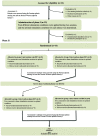Comparison of the Effect of Four Transcranial Direct Current Stimulation Configurations on Picture-Naming Improvement in Non-Fluent Aphasia: A Randomized Clinical Trial
- PMID: 37791330
- PMCID: PMC10542920
- DOI: 10.30476/ijms.2022.94867.2619
Comparison of the Effect of Four Transcranial Direct Current Stimulation Configurations on Picture-Naming Improvement in Non-Fluent Aphasia: A Randomized Clinical Trial
Abstract
Background: Anomia is a language disorder that negatively affects communication abilities in people with aphasia (PWA). We aimed to compare the effect of transcranial direct current stimulation (tDCS) over the left and right inferior frontal gyrus (IFG) and superior temporal gyrus (STG) on the picture-naming accuracy and reaction time in PWA.
Methods: A randomized, single-blind, sham-controlled crossover trial was conducted in 2021 at Mobasher Kashani Clinic, Hamadan, Iran. Sixteen patients received both five days of real-tDCS (1 mA for 20 minutes) and five days of sham-tDCS with a seven-day washout period in between. Using the Persian aphasia naming test, picture-naming accuracy and reaction time on 50 images were assessed at baseline, real-tDCS, and sham-tDCS stages. The data were analyzed using STATA software, version 11.0. P<0.05 was considered statistically significant.
Results: Sixteen non-fluent PWA participated in the study. Of all patients, 64% benefited from tDCS over the STG and 18% over the IFG. The results showed that real-tDCS had a significant effect on the picture-naming accuracy (P=0.003) and the Persian-Western aphasia battery-one score (P=0.01), whereas sham-tDCS had no noticeable effects. Both the real- and sham-tDCS had no significant effect on the reaction time (P=0.28).
Conclusion: Five sessions of individualized tDCS protocol (1 mA for 20 minutes) were adequate to improve picture-naming accuracy in patients with chronic aphasia.
Keywords: Anomia; Aphasia; Reaction time; Transcranial direct current stimulation.
Copyright: © Iranian Journal of Medical Sciences.
Conflict of interest statement
None declared.
Figures



Similar articles
-
Anodal transcranial direct current stimulation in early rehabilitation of patients with post-stroke non-fluent aphasia: a randomized, double-blind, sham-controlled pilot study.Restor Neurol Neurosci. 2013;31(6):761-71. doi: 10.3233/RNN-130333. Restor Neurol Neurosci. 2013. PMID: 24047756 Clinical Trial.
-
Repetitive sessions of tDCS to improve naming in post-stroke aphasia: Insights from an individual patient data (IPD) meta-analysis.Restor Neurol Neurosci. 2018;36(1):107-116. doi: 10.3233/RNN-170783. Restor Neurol Neurosci. 2018. PMID: 29439369
-
Comparison of two configurations of transcranial direct current stimulation for aphasia treatment.J Rehabil Med. 2018 Jun 15;50(6):527-533. doi: 10.2340/16501977-2338. J Rehabil Med. 2018. PMID: 29736552 Clinical Trial.
-
Transcranial direct current stimulation (tDCS) to improve naming ability in post-stroke aphasia: A critical review.Behav Brain Res. 2017 Aug 14;332:7-15. doi: 10.1016/j.bbr.2017.05.050. Epub 2017 May 29. Behav Brain Res. 2017. PMID: 28572057 Review.
-
Taking Sides: An Integrative Review of the Impact of Laterality and Polarity on Efficacy of Therapeutic Transcranial Direct Current Stimulation for Anomia in Chronic Poststroke Aphasia.Neural Plast. 2016;2016:8428256. doi: 10.1155/2016/8428256. Epub 2015 Dec 27. Neural Plast. 2016. PMID: 26819777 Free PMC article. Review.
References
-
- Baker JM, Rorden C, Fridriksson J. Using transcranial direct-current stimulation to treat stroke patients with aphasia. Stroke. 2010;41:1229–36. doi: 10.1161/STROKEAHA.109.576785. [ PMC Free Article ] - DOI - PMC - PubMed
-
- Jung IY, Lim JY, Kang EK, Sohn HM, Paik NJ. The Factors Associated with Good Responses to Speech Therapy Combined with Transcranial Direct Current Stimulation in Post-stroke Aphasic Patients. Ann Rehabil Med. 2011;35:460–9. doi: 10.5535/arm.2011.35.4.460. [ PMC Free Article ] - DOI - PMC - PubMed
Publication types
MeSH terms
LinkOut - more resources
Full Text Sources
Medical
